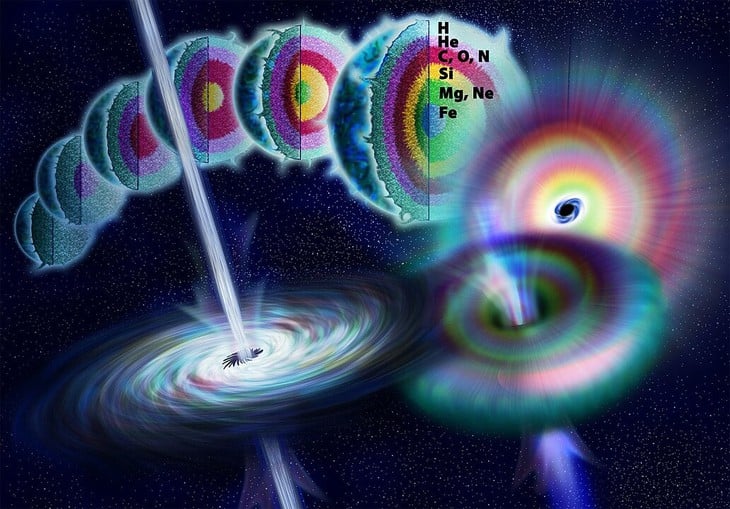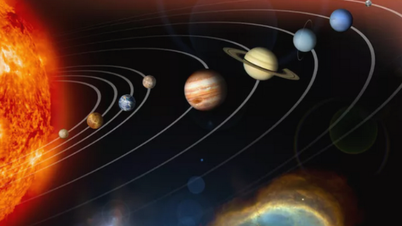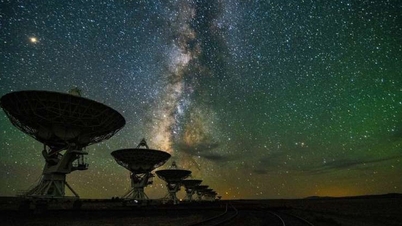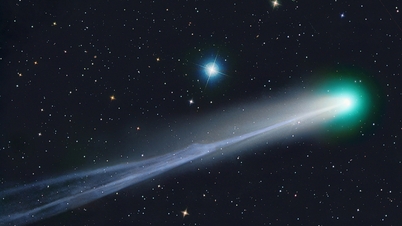
Illustration of the life cycle of a massive star: nuclear fusion in the core converts light elements into heavier ones; when this reaction no longer exerts enough pressure to counteract the force of gravity, the star collapses and forms a black hole. During that collapse, energy can be released as a brief gamma-ray burst along the star's rotation axis - Photo: National Science Foundation
According to Lives Science , gamma rays are the brightest and most violent explosions in the universe, able to shine brighter than billions of stars combined in just a few short seconds. The energy they emit in a moment is greater than the entire energy the Sun produces in its 10 billion years of existence. However, these explosions usually only last from a few thousandths of a second to a few minutes and then quickly disappear.
On March 7, 2023, satellites recorded a special gamma-ray burst called GRB 230307A, the second brightest explosion ever detected in history. Its origin was determined to be the collision and merger of two neutron stars in a distant galaxy. Normally, this type of explosion lasts less than 2 seconds, but GRB 230307A lasted for up to 1 minute, leaving scientists extremely surprised.
An international team of researchers from the University of Hong Kong, Nanjing University and the Chinese Academy of Sciences decided to investigate further. They analyzed more than 600,000 sets of data collected from the GECAM (China) and Fermi (NASA) satellites.
They found a regular, repeating signal hidden in the burst, like the steady beat of a heart. This signal showed that the star was rotating at a rate of 909 revolutions per second, indicating the existence of a newly born magnetar (a neutron star with an extremely strong magnetic field). This is the first time in the history of science that a periodic signal has been directly recorded from a millisecond magnetar within a gamma-ray burst.
The phenomenon lasted just 160 milliseconds, so short that it seemed fleeting. Scientists believe the magnetar’s powerful magnetic field and its incredible rotational speed created a “heartbeat fingerprint” on the gamma ray beam. However, because the radiation stream fluctuated so rapidly, the signal was only visible for a moment when the beam became symmetrical, then disappeared when the structure became symmetrical again.
"This discovery confirms for the first time that not all gamma-ray bursts originate from black holes, but some are powered by newborn magnetars," said study co-author Professor Bing Zhang of the University of Hong Kong.
This discovery opens up a whole new field of research into the origin of gamma-ray bursts, and connects many areas of astrophysics such as gravitational waves, compact stars and extreme magnetic fields, the most extreme conditions known in the universe.
Source: https://tuoitre.vn/phat-hien-nhip-tim-vu-tru-trong-vu-no-tia-gamma-cuc-manh-20251020005928945.htm







![[Photo] Cat Ba - Green island paradise](/_next/image?url=https%3A%2F%2Fvphoto.vietnam.vn%2Fthumb%2F1200x675%2Fvietnam%2Fresource%2FIMAGE%2F2025%2F12%2F04%2F1764821844074_ndo_br_1-dcbthienduongxanh638-jpg.webp&w=3840&q=75)





















































![[VIMC 40 days of lightning speed] Da Nang Port: Unity - Lightning speed - Breakthrough to the finish line](https://vphoto.vietnam.vn/thumb/402x226/vietnam/resource/IMAGE/2025/12/04/1764833540882_cdn_4-12-25.jpeg)














































Comment (0)